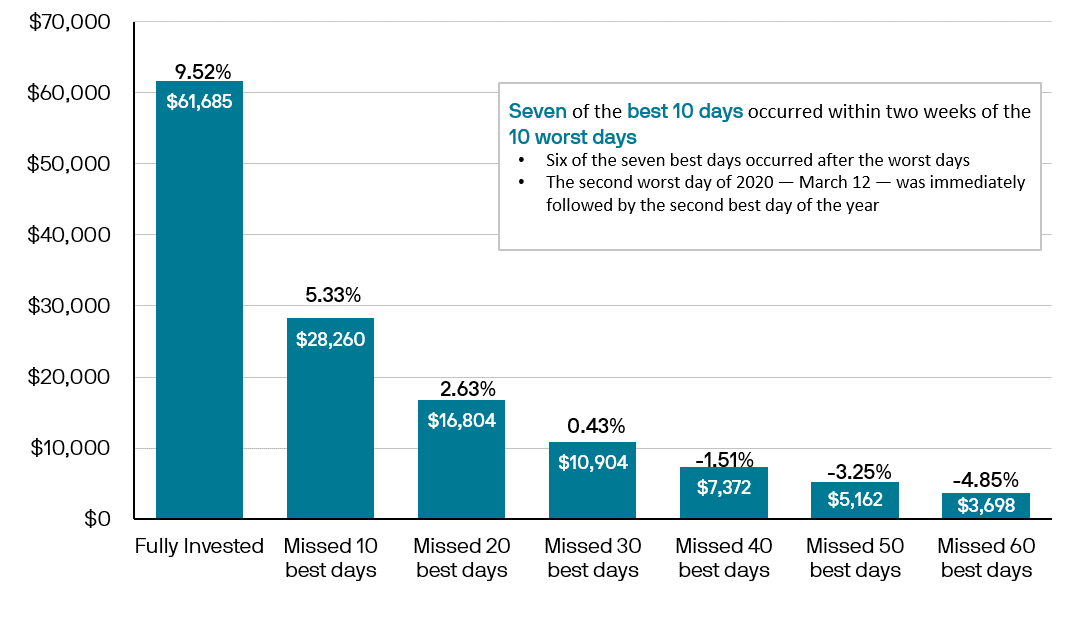Written by: Jack Manley
Success in both investing and retirement requires investors to focus on what they can control, like saving patterns and asset allocation. During periods of extreme volatility, emotions can often interfere with this success. Despite efforts by financial advisors, investors may be tempted to take control in a way that is likely to be detrimental, selling out of the market after a significant drawdown – and locking in losses – with a plan to re-enter when things feel “safer”.
This behavior is driven by “loss aversion” – the desire to avoid additional losses because losses feel more painful than gains feel good. However, what most investors aren’t aware of is how closely the best days often follow the worst, and how important those good days are to the recovery of a portfolio.
The chart below, from our 2022 Guide to Retirement, helps to explain this concept, illustrating its worst-case outcome. It compares the return experience of an untouched $10,000 investment in the S&P 500 over the past 20 years to a return that is impacted by missing some of the best days as a result of premature selling.
As of year-end 2021, seven of the best days have occurred within two weeks of their corresponding worst day; often the spread is much closer than that. For example, March 12, 2020 was the second-worst day of the year, and was immediately followed by the second-best day of the year. Moreover, the worst days overwhelmingly occur before the best days: over the last 20 years, six of the seven best days occurred after the worst day.
Given this reality, should an investor sell after experiencing a poor return, it is impossible to re-invest in time to benefit from the best day that may follow. Will this investor miss the best 10 or 20 days? Likely not – but this illustrates how repetitive “loss aversion”-induced selling can significantly erode returns.
However, some may ask: what if an investor misses the worst days but still benefits from the best? There are two key issues with this question:
- First, there is no guaranteed “signal” to get out of the market, and market bottoms are only determined in hindsight.
- Second, the investor would need to buy in on the worst days during some of the most significant market drawdowns when loss aversion is at its greatest.
As a result, it is hard to believe that someone could be smart enough to consistently miss the worst days while courageous enough to invest for the best days.
Unfortunately, 2022 will likely remain volatile for equity markets, as central banks normalize alongside persistently hot-inflation and geopolitical issues result in prolonged uncertainty. Therefore, it is important to remind investors that success is achieved through time in the market, not timing the market. And, to quote Dolly Parton, “If you want the rainbow, you gotta put up with the rain.”
Returns of the S&P 500
Performance of a $10,000 investment between January 1, 2002 and December 31, 2021

Related: What Are the Impacts of Rising Energy Prices?
Source: J.P. Morgan Asset Management analysis using data from Bloomberg. Returns are based on the S&P 500 Total Return Index, an unmanaged, capitalization-weighted index that measures the performance of 500 large capitalization domestic stocks representing all major industries. Indices do not include fees or operating expenses and are not available for actual investment. The hypothetical performance calculations are shown for illustrative purposes only and are not meant to be representative of actual results while investing over the time periods shown. The hypothetical performance calculations are shown gross of fees. If fees were included, returns would be lower. Hypothetical performance returns reflect the reinvestment of all dividends. The hypothetical performance results have certain inherent limitations. Unlike an actual performance record, they do not reflect actual trading, liquidity constraints, fees and other costs. Also, since the trades have not actually been executed, the results may have under- or overcompensated for the impact of certain market factors such as lack of liquidity. Simulated trading programs in general are also subject to the fact that they are designed with the benefit of hindsight. Returns will fluctuate and an investment upon redemption may be worth more or less than its original value. Past performance is not indicative of future returns. An individual cannot invest directly in an index. Data as of December 31, 2021.



